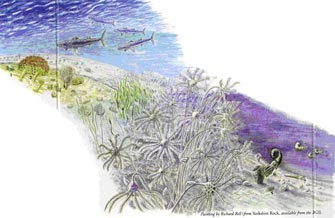
Ancient environments
Silurian l Devonian l Carboniferous l Triassic l Jurassic
Life in the Early Carboniferous, 359 – 327 million years ago
During the Early Carboniferous the Mendip area was part of a broad, shallow, tropical sea that stretched westwards into Pembrokeshire, and across which thick successions of Carboniferous Limestone, now forming the Mendip hills, was being deposited. A rich variety of life inhabited this marine environment, particularly corals, brachiopods and crinoids, which are the most commonly occurring fossils.
Crinoids
Crinoids inhabited shallow water and grew in dense clusters, sometimes called 'crinoid gardens' because of their resemblance to plants. Long stems were anchored to the sea bed, and held aloft a globose, cup-like structure with radiating arms. The whole animal is formed of many individual plates that usually become scattered when the creature dies. The stem plates are common fossils and the main constituent of crinoidal limestone.
Corals
Like modern-day coral reefs, the abundant remains of fossil corals in the Carboniferous limestone suggest the former existance of warm, clear, shallow and well-lit tropical seas. Corals have a variety of branching and encrusting shapes that provide homes for other creatures and act as a baffle to trap sediment. Different kinds of fossil corals occur at different levels in the limestone, allowing geologists to distinguish between older and younger beds.
Brachiopods
Brachiopods have become all but extinct in modern seas and oceans, but in the geological past they flourished at the shallow margins of oceans, especially in the Carboniferous. At first they appear little different from familiar modern-day sea shells, but they are in fact quite distinct, with different shell and soft part anatomy. Many brachiopods lived openly on the sea bed, but some such as Lingula, occurring near the base of the Carboniferous Limestone, inhabited burrows. Two important groups of brachiopods in the Carboniferous are strongly radially ribbed forms, called 'spiriferids', and large, less strongly ribbed forms with relatively plano-convex valves, called 'productids'.
- Home
- Overview maps
- Locality
areas
- Cheddar Gorge
- Charterhouse
- Blackdown
- Burrington Combe
- Shipham & Rowberrow
- Crook Peak & Axbridge
- Banwell to Churchill
- Priddy
- Harptree & Smitham Hill
- Draycott & Westbury-sub-Mendip
- Wookey Hole & Ebbor Gorge
- Wells
- Great Elm & Vallis Vale
- Mells & the Wadbury Valley
- The Vobster area
- The Whatley area
- Torr Works & Asham Wood
- Beacon Hill
- Stoke St Michael & Oakhill
- Holwell & Nunney
- Shepton Mallet & Maesbury
- Gurney Slade & Emborough
- The Nettlebridge valley
- Geology
- Minerals and mines
- Quarrying
- Caves and karst
- Biodiversity
- Detailed site information
- Acknowledgements
- External links
- Search
- Site map
